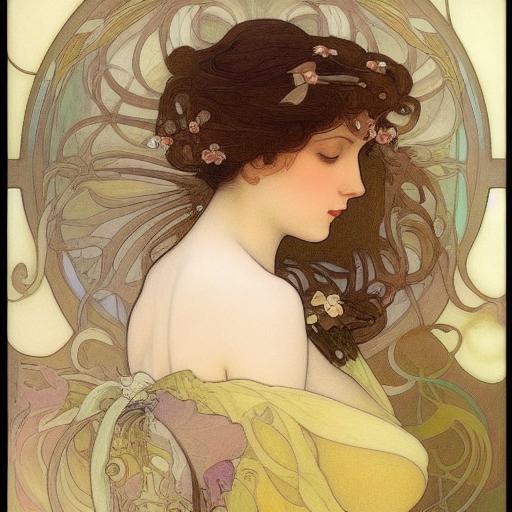Start AI Image Generation from writing prompt
When it comes to generating AI images with different image generator, such as Imagen and DALL-E, the prompt we provide serves as a guiding force in shaping the generated artwork. Let’s explore the impact of a specific prompt: “a painting of a woman with a ribbon in her hair, an art nouveau painting, inspired by Alphonse Mucha, elegant, artistic, featuring plants and flowers.” This prompt sets the foundation for an art piece influenced by the art nouveau movement and the distinctive style of Alphonse Mucha.
By specifying that the artwork is an art nouveau painting, we direct the AI image generator to draw inspiration from the ornamental, flowing lines and organic forms characteristic of this artistic style. Alphonse Mucha, a renowned art nouveau artist, serves as a point of reference for the AI, guiding it to replicate the elegance and intricate details often found in Mucha’s works.
The mention of a woman with a ribbon in her hair suggests a graceful and feminine subject, while the terms “elegant” and “artistic” provide additional cues for the AI to emphasize sophistication and creativity in the painting. The inclusion of plants and flowers further enhances the art nouveau theme, as these elements are commonly featured in Mucha’s iconic works. The AI can interpret and incorporate various floral motifs, such as vines, leaves, or blossoms, to complement the woman’s appearance and add an organic and harmonious touch to the overall composition.
Through the interplay between the prompt and the AI image generator, an art piece inspired by the art nouveau movement and Alphonse Mucha‘s style begins to take shape. The AI’s ability to analyze and translate textual prompts into visual representations allows for the creation of unique and visually appealing artworks that capture the essence of art nouveau’s elegance and natural beauty.
Why they close their eyes
The depiction of female characters with closed eyes in artworks can carry various symbolic and aesthetic meanings. Closing the eyes can add an air of mystery and intrigue to the character, inviting viewers to ponder the emotions and thoughts hidden behind the closed eyelids. It can create a sense of introspection, serenity, or a moment of deep contemplation. By closing the eyes, the focus shifts from the external world to the inner world, suggesting a connection with emotions, dreams, or spiritual realms.
Additionally, closed eyes can enhance the aesthetic appeal of the artwork. They allow the artist to emphasize other facial features, such as the delicate curves of the eyebrows, the graceful contours of the eyelids, or the subtle shadows and highlights created by the closed-eye effect. This can create a sense of elegance, tranquility, or even vulnerability, which can be visually captivating and emotionally engaging to the viewers.
While the attractiveness of closed-eyed female characters is subjective and can vary from person to person, the artistic choice to depict them in such a manner often adds a layer of allure and intrigue to the artwork. It encourages viewers to explore the deeper emotions and narratives conveyed through the closed eyes, and invites them to interpret and connect with the artwork on a more intimate and personal level.
Benefits of choosing the same color tone
Choosing the same color tone for a painting, with the exception of the character in the middle, offers numerous benefits. Firstly, it helps create a visual focus by drawing immediate attention to the central character. The contrast between the character and the surrounding colors emphasizes their presence, making them stand out as the focal point of the painting. This can be particularly effective in capturing the viewer’s attention and guiding their gaze towards the main subject.
Furthermore, using a different color tone for the central character can contribute to the narrative emphasis of the artwork. It highlights the character’s significance within the overall story or theme, adding depth and meaning to the composition. The intentional color contrast can evoke specific emotions or moods, creating a stronger emotional impact and enhancing the storytelling aspect of the painting. This deliberate use of color can greatly enhance the overall atmosphere and resonance of the artwork.
From a compositional standpoint, selecting a single color tone for the background elements helps create a sense of unity and balance. It establishes a visual harmony between the character and their surroundings, ensuring that the artwork feels cohesive and well-composed. The color contrast adds depth and dimension, giving the central character a three-dimensional presence against the flatter background.
In terms of practical application, when we generate an image with a specific color tone, we can carry that same color scheme over to other design tools such as Visual Paradigm Online. By designing in the same color tone, we can maintain a consistent aesthetic across different elements of our project. This creates a sense of coherence and harmony in our overall design, whether it’s a presentation, infographic, or any other visual composition.


